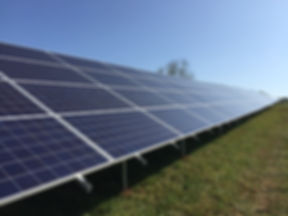
SOLAR ENERGY INCENTIVES
Incentives for solar energy, energy storage, energy management, and energy efficiency projects can help reduce project costs. Incentives most often come in the way of federal tax credits (ITC) and grants. In some instances additional incentives may be available regionally. TMI's development team are experts when it comes to fully utilizing available resources to reduce project costs such as USDA REAP grants and ITC for non-profits. Read on for more information about PV incentives.
FEDERAL TAX CREDITS (ITC)
Since 2006, the solar Investment Tax Credit (ITC) has provided a great incentive for tax paying companies and individuals to go solar. Over the years the amount of the credit has changed, adjusting up and down, and the credits have been renewed by congress on multiple occasions. In August 2022, Congress enacted the Inflation Reduction Act (IRA) that expanded on the existing tax credit in meaningful ways, but most importantly it locked in the incentive for a ten year period. How the ITC stands today:
Current Base ITC Amount: 30%
Solar energy installations less than 1MW AC are eligible for a base savings of 30% for the total cost of the system. Projects over 1MW AC have additional requirements to be eligible for the base ITC amount. TMI's development team provides a detailed savings plan for each project as a part of our free feasibility assessment.
Additionally, your cost to go solar may be further reduced if either of the following bonus credits apply to your project:
Domestic Material Bonus Credit: 10%
On applicable projects, an additional 10% tax credit may be applied to the total cost of the system when USA made equipment is installed. Domestic materials may consist of: PV modules, racking/structure, inverters, optimizers and other rapid shutdown devices, AC equipment, wire, conduit, steel, etc..
Energy Community Bonus Credit: 10%
For projects located in designated areas, in an additional 10% tax credit may be applied to the total cost of the system. Energy communities are defined as:
-
Brownfield Site - Property that have the presence or potential presence of pollutants, contaminants, or hazardous substances.
-
Metropolitan or Non-Metropolitan Statistical Area - Meets direct employment or local tax revenue requirements related to the extraction, processing, transport, or storage of coal, oil, or natural gas; and has an unemployment rate at or above the national average for the previous year.
-
Census Tract (or adjoining) - Where a coal mine has closed after 1999; or a coal-fired generator has been retired after 2009.
Non-Profits Can Now Utilize The ITC
Prior to the Inflation Reduction Act it was not common for non-profits to own their systems outright. Without access to tax credit savings the non-profit would ultimately pay more for their system than a tax paying entity. Going solar as a non-profit typically resulted in the organization signing a PPA, and after a third party had utilized all of the tax credits, the system may then be sold at a reduced rate to the non-profit. While PPA's are still the preferred option for non-profits due to their low cost of entry, and more, direct purchases may be a better fit for some organizations. Click here to read more about solar energy for non-profits.
How it works: Exempt non-profits do not pay taxes, so any amount paid in taxes results in a refund. The solar ITC will operate the same way in that applying the tax credit to your annual taxes will simply show that your organization has paid too much in tax, resulting in a refund. A second option allows for a non-profit to purchase their system and utilize the tax credit by transferring the credits to an eligible tax payer or entity. More information about "Direct Pay" can be found here.
USDA REAP GRANTS & LOANS
Starting in 2015, USDA began offering grants and loans to small businesses in designated rural zones and agricultural producers. These grants and loans may be used for energy efficiency improvements and/or the installation of renewable energy systems. You can easily check if your business is located in a rural zone by searching your address on the USDA Eligibility Map. Agriculture producers do not have to be located in a rural zone to be eligible for REAP funding. For questions about REAP funding and how it may apply to your business, reach out to us for your free solar energy feasibility assessment.
What's Eligible For Funding?
USDA has a list of upgrades and systems that are eligible for funding that includes electric generating equipment such as solar energy / photovoltaics, and energy efficiency upgrades like lighting, insulation, and doors and windows. For a current list of how the REAP funds may be used visit the USDA REAP webpage.
How Much Funding Is Available?
Per the USDA website:
-
Loan guarantees on loans up to 75% of total eligible project costs
-
Grants for up to 40% of total eligible project costs
-
Renewable Energy Systems:
-
$2,500 minimum
-
$1 million maximum
-
-
Energy Efficiency:
-
$1,500 minimum
-
$500,000 maximum
-
-
-
Combined grant and loan guarantee funding up to 75% of total eligible project costs
Requirements:
Per the USDA website:
-
Applicants must provide at least 60 percent of the project cost if applying for a grant only
-
Applicants must provide at least 25 percent of the project cost if applying for a loan
-
All projects must have technical merit and utilize commercially available technology
-
Energy efficiency projects require an energy audit or assessment




